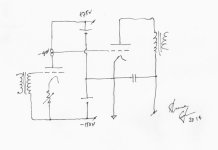What if....you had less B+ than you wanted, so instead of grounding the cathode, pull it negative to ground with a "B-" supply (like is done with fixed-bias power tubes)? Only takes a diode, a filter cap, and a resistor to control it. Then of course bias the grid even more negative... you could make 90V on the plate look like twice that! Anyone every needed to try this?
I tried it with a split rail supply like that, actually I like it because you can juggle it so that the plate voltage of that stage is equal to the bias voltage of the next stage, you can DC couple this way without the need for any RC in the cathode of that next stage because its cathode is at 0V. You will need to provide some DC blocking for whatever is feeding the first stage because its grid won't be at 0V. Transformer works well.. some really nice mic. transformers for low level application, small, shielded and not too expensive.
isn't pulling the cathode negative wrt ground the same thing as raising the B+ and moving the ground reference? we are, after all, just talking about relative voltage levels regardless of the application.
Kuroguy: Yes it is the same, but if you don't have the B+, how can you increase the relative voltage levels (difference)? Go below ground, with a negative rail (sorta like OP amps use?). I only have 117VAC, want 150VDC or more on a triode preamp plate (without resorting to voltage supply doublers, etc.
call it what you want. take that negative 33 volts (117-150) that you have connected to the cathode which requires a change in the bias resistor and add it to the anode and you're at the exact same 150 volts without messing with the bias resistor.
Two options: add a negative supply; use a voltage doubler PSU. Both of these are essentially the same circuit - it just depends which point you ground.
Thanks for all the feedback - looks like it could work, whether it be a negative supply or voltage doubler. Will definitely look into later...I'm dying to put a tremelo on this amp, which will be a learning process in itself. I have Fender, Gregory and Weber circuits (both tube and SS) to compare and adapt, to "wobble" the preamp plate voltage.
Some of things that change when using a split rail supply are heater to cathode potential and DC grid voltage. The tube biases the same way, in that its the difference between cathode and grid voltage that sets the plate current for the stage, so using a split rail supply (all else the same) doesn't actually change the bias of the tube.
Attachments
Last edited:
you'll have to filter the neg supply real good if your signal is referenced to ground.
ran into this when placing tube preamp into SX 3700 to test.
better to use a voltage tripler for B+ and reference all signal to ground.
The input transformer may allow you to be ok
ran into this when placing tube preamp into SX 3700 to test.
better to use a voltage tripler for B+ and reference all signal to ground.
The input transformer may allow you to be ok
Keep in mind the heater-cathode insulation's maximum voltage rating. If all the heaters are referenced to ground as usual, then the entire negative "B-" voltage shows up across the h-k insulation. That may be too much for the insulation.instead of grounding the cathode, pull it negative to ground with a "B-" supply
<snip>
Then of course bias the grid even more negative...
For reasons I don't understand, it also seems that (some?) valves can tolerate less heater-cathode voltage when the cathode is negative. For instance, the EF86 has a maximum h-k voltage limit of 100 volts when the cathode is positive, but only 50 volts when it is negative.
Your idea should work, but "B-" should probably be kept quite small, no more than 50 volts or so, if the valves are to live long lives. Given that limitation, I would be inclined to put a voltage doubler circuit on the transformer to increase B+, rather than try and run some valves with an additional B-.
-Gnobuddy
- Status
- Not open for further replies.
- Home
- Live Sound
- Instruments and Amps
- Bias a triode cathode negative for more gain?
